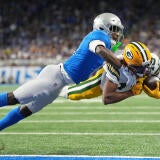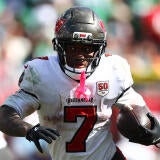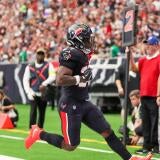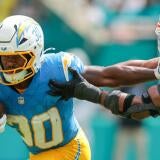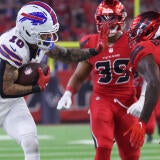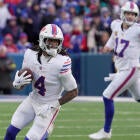2019 Fantasy Football Draft Prep: The best way to identify values at running back
Wouldn't it be great if we had one stat that could help identify sleepers, breakouts and busts for running back? Ben Gretch has an idea.
Once upon a time, identifying the best running backs was as easy as understanding the concepts of opportunity and efficiency. Who was in line to get the most touches? Whose production the prior season was due to an unsustainable yards per carry or touchdown rate?
In 2019, identifying backs to target isn't as simple. The market has adjusted. Drafters know what to look for.
Or do they?
I've studied running back receiving value for several seasons. It's one of two major factors I consider for running back production, along with touchdown potential. But as the market has adjusted and drafters have become more efficient at selecting running backs, there's a third component of running back Fantasy scoring I actively fade: Inefficient "touch mix." You want guys who get the ball in the right spots. Here's why.
Some historical context
Let's start with receiving. Over the past few years, as league-wide trends have shifted and more Fantasy leagues employ point-per-reception (PPR) scoring, receiving production has become more important.
The below charts detail the top 30 running backs by end-of-season finish in PPR scoring for each of the past 15 seasons. Apologies for the busyness of the charts; the heat map paints a picture of evolving trends.
The first chart is simply rush attempts for each player-season. Each column is a year, while each row is a specific player finish, so the top row (RB1) refers to Saquon Barkley in the 2018 column, Todd Gurley in 2017, and David Johnson in 2016.
The first thing that jumps out is far more green the further right you move, indicating better performances from backs who notched fewer rush attempts over the last decade and a half.
That's in part because of the decline of monster rushing workloads. In every season on this chart prior to 2011, at least five running backs crested the 300-carry threshold. Exactly one player has done that in each of the past five seasons.
In conjunction with that decline in workhorses, receiving specialists emerged, then showed off real Fantasy upside. Darren Sproles broke the mold with the RB5 season in 2011 while notching just 87 rush attempts. From 2015 to 2018 we've seen seven more RB1 performances from backs who rushed 125 or fewer times, highlighted by Danny Woodhead's RB3 season in 2015, Alvin Kamara's RB3 season in 2017, and James White's RB7 season last year.
Here is a similar heat map, but instead of rushing attempts, we're looking at receptions.
There is a less pronounced trend here, but over the past two seasons, all of the top nine backs caught at least 50 passes. On top of the increase of receiving specialists, recent seasons have brought us the era of the uber back, elite workhorses who have traded off some rushing work for an increase in receptions.
In today's Fantasy landscape, you better have some receiving potential or you'll have a hard time pushing the top five of the position.
How to choose running backs
Along with receiving potential, elite backs need touchdown upside. And touchdown upside is very closely tied to where touches occur.
Each yard line closer to the goal line increases the rate of touchdowns exponentially — the highest rate naturally comes from plays that begin on the 1-yard line — but it's around the 10 where rates start to level off across the rest of the field.
Per the RotoViz Screener, over the past five seasons, 70.2% of running back touchdowns have come on plays that started at the 10-yard line or closer, despite that area of the field accounting for just 7.2% of total running back touches. We'll call that area the green zone.
So we should target players who catch passes and get green zone touches. That makes sense. But the important question to ask is: What does that leave?
I like to think of running back touches in three groups: receiving work, rushing work and those green-zone touches. Green-zone touches are, of course, either receptions or rush attempts, but it makes sense to break those out because of the way higher scoring rates.
When you break it down this way, something becomes clear. If receptions and green-zone work are the keys to big running back Fantasy totals, and if drafters value big touch counts, then the edge lies in actively devaluing the third group of running back touches. We should fade players who see a high percentage of their touches on rush attempts, specifically those that don't come in the green zone.
Over the past five seasons, 75.1% of all running back touches were this type of low-impact rush attempt. Just 42.1% of all running back Fantasy points in the same sample were scored on these plays. Fantasy drafters and analysts alike love 20-carry games, but when they come without receptions and from a player on an offense with limited scoring opportunities, that is an empty workload. It doesn't translate to Fantasy points.
But if we flip those numbers to look at just receptions and green-zone touches, we see that 57.9% of Fantasy points came from a little less than a quarter of total running back touches.
How this impacts individual players
Full disclosure: I was going to wrap up this article above, but I started looking at how individual player's touch rates split out in various seasons, and I think I've found my new favorite running back stat.
The only problem is I don't know what to call it.
The stat is that percentage of total touches that are non-green zone rush attempts. Non-green zone rush attempt percentage (NGZRAP)? Carries outside green zone as percentage of total touches (COGZAPOTT)?
These are not good acronyms. (Note: After publication, my former podcast co-host Pat Kerrane nailed this. It will henceforth be known as TRAP, for Trivial Rush Attempt Percentage.)
But the stat is great. It identifies the touch mix to seek to identify players who will outperform their draft slot, assuming draft slot follows projected touches somewhat closely. It also identifies the players to avoid.
Receiving specialists definitely get a boost, so you have to account for that, but the best ones in the stat are the best because they also get green zone looks. Remember the recent peak receiving specialist seasons I mentioned before? Part of Woodhead's Fantasy value with the Chargers was his red zone usage; Kamara's Saints love to feature backs in close; and because the Patriots often hurry up to the line after they complete passes inside the 10, White notched 15 green-zone rush attempts last year, tied for 21st most among all backs, despite rushing just 94 times overall. In other words, those are the type of passing down backs you'd want to target.
All three of those seasons were among the 15 lowest TRAPs out of 238 running back player-seasons with over 100 Fantasy points in the past five years. For White, his 2018 breakout is pretty easily explained by his 2015, 2016 and 2017 being the three lowest rates on the list. He always had this touch mix. (Kamara was a rookie when he broke out, and Woodhead was injured the year before, but also had a very low TRAP in his first season with the Chargers, 2013).
Kamara's 2018 also shows up among the 30 lowest rates of those low-value touches, as do both of Christian McCaffrey's two seasons to date, and a guy I love to target, Damien Williams. So it's not just receiving backs. Heard these guys are due for regression? Consider that their roles mean ceding low-value touches for high-value ones.
There are other great indicators in the data. David Johnson's rookie season in 2015 foretold his 2016 breakout, while his 2018 usage was worse than average and explains his poor season.
That end of the stat also includes guys I'm fading this year like Derrick Henry and Sony Michel, and explains why. I'll need to do more digging into this stat, but here's the leaderboard from the past five seasons.








